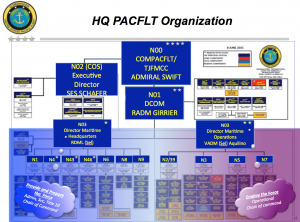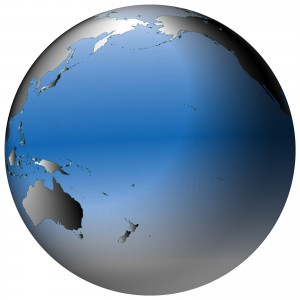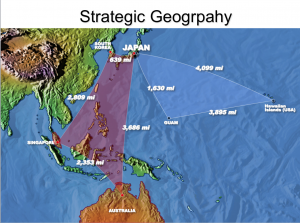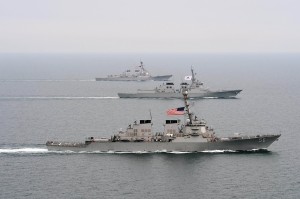Pac Fleet operates in the largest area of operations for US forces.
The immensity of the theater of operations, as well as the dynamics of change in the region, pose ongoing challenges of matching resources against tasks in protecting US interests and working closely with allies and partners.
Recently, I had a chance to sit down with the PACFLEET’s Director of Maritime Operations, Rear Admiral Aquilino to discuss the challenges and the way ahead.
In his current position, he is at the vortex of the operational capabilities and deployment of the fleet, and is positioned to understand the dynamics of shaping strategy up against the ongoing challenges and threats in the Pacific.

Against the backdrop of a growing chorus of comments Inside the Beltway about the growing ability of the Chinese to purse an effective area denial strategy, Admiral Aquilino presented a different perspective.
Clearly, China is improving its capabilities to operate in the Pacific, and quantity has a quality all of its own, but the Chinese are coming out into the Pacific, and the are not “12 feet tall.”
The Admiral highlighted that the Pacific when all is said and down is a maritime domain, and learning to operate in the blue water and to operate from the sea into the littorals is an art form which needs to be learned, and not just assumed.
The US Navy has a long history in the region, and has gone through many learning cycles.
And the strategy in the Pacific was simply put by the Admiral: “We need to have the ability to operate where it matters and when it matters. And we can do that.”
He followed the lead of the CNO who emphasizes that if one fight the high end fight, one can adapt to the other challenges; but the reverse is not necessarily true.
We discussed distributed lethality and the evolving US Navy’s joint and coalition approach to deploying diversified and distributed capabilities which can when combined in coordinated concepts of operations deliver what is needed in the area of interest.
“What I think is meant by distributed lethality is an ability to have an agile and diversified force operating over an extended battlespace but with an ability to concentrate force against the crucial tasks, targets and goals to execute an effective strategy.”

F-35C on approach to a landing aboard the USS Nimitz. Credit Photo; Breaking Defense
When asked what technologies are coming to the Pacific which we enable PACFLEET to achieve this strategy more effectively, he quickly focused on the coming of the F-35 to the fleet and to the region.
“I mentioned earlier that our task is clearly that we need to have the ability to operate where it matters and when it matters.
The F-35 will enhance our ability to do so.
Although I am a naval aviator, I am not speaking as one when I make this point about the new aircraft.
It is a force multiplier and enhancer not just a new combat aircraft. It clearly will enhance or air-to-air and air-to-ground capabilities, but it as a deployed and integrated sensor aircraft it extends our reach and expands our flexibility and agility.”
He focused on the F-35’s role organically with PACFLEET (on carriers and on amphibious ships) but also in terms of being able to draw from the sensor stream of a deployed USAF as well as allied force of F-35s.
“The integration of the sensor grid is a crucial and evolving capability which will be expanded as the F-35 enters the Pacific.”
My colleague Ed Timperlake referred to the evolution, which the Admiral was discussing as the 21st Century variant of the “big blue blanket.”
As we put in our book on the evolution of Pacific strategy:
“In World War II, the USN shaped what became called the big blue blanket of ships to cover the Pacific operations.
Obviously, this is beyond the ken of current realities, but shaping a connected set of U.S. and allied forces able to work together to shape defense and security in the Pacific is not.” [ref]Laird, Robbin F.; Timperlake, Edward (2013-10-28). Rebuilding American Military Power in the Pacific: A 21st-Century Strategy: A 21st-Century Strategy (The Changing Face of War) (Kindle Locations 213-215). ABC-CLIO. Kindle Edition.[/ref]
The Admiral clearly had a similar thought in mind in our discussion.
And clearly was not ceding ground against those who assume that an area denial strategy was already effectively in place.
U.S. Navy Biographies – REAR ADMIRAL JOHN C
Later I had a chance to discuss with senior PACFLEET staff how PACFLEET is working the way ahead along the lines discussed by Rear Admiral Aquilino.
I had a chance to talk with an learn for four senior members of the PACFLEET staff in addition to the earlier interviews published recently.
Captain Mark “JP” Sousa is PACFLEET Liason to PACAF and focuses on C2 issues in working the evolution of the force. He operates from the 613th Air Operations Center at Hickam.
Captain Sousa is a former Tomcat pilot, and given the key role which the F-14s played in the chain saw strategy for the carrier battle groups, it is not surprising that the F-14 pilots are playing a key role in the Navy’s transition to distributed operations.
The head of Naval Air Warfare as well as the head of PACFLEET operations are both former F-14 pilots.

The Pacific from the Arctic to Australia Credit Image: Bigstock
It is important to underscore how the F-14 operational experience anticipates in some ways the coming of the F-35 to the fleet and its impact on C2, ISR and strike.
As Ed Timperlake puts it:
“The USAF had real early experience with stealth with the F-117 Nigh Hawk leading the way. Concurrently the Navy had excellent experience with their F-14 fighter community in developing technology, a state-of-the art radar and a missile Aim-54, that could reach out and touch someone.
After the Vietnam War, the US Navy introduced the F-14 and began again the never ending process of always evolving the training, tactics and command and control to push the threat from a reactive enemy out as far as possible from a Carrier Battle Group (CBG).
The CBG could then conduct combat strikes against all targets, land air and sea.
This evolution of reach and range technology and cockpit enhanced situational awareness driving training and tactics will be soon be seen in the nature of changing command and control relationships as the F-35 enters the Sea Services inventory.”
(See also, http://www.sldinfo.com/shaping-an-operational-strategy-in-the-pacific-an-interview-with-rear-admiral-john-aquilino/).
Captain Kevin Melody works ballistic missile and air defense issues for PACFLEET and has significant experience with the surface fleet, including Aegis.
Captain Patrick Walsh is director of Deliberate Planning for PACFLEET and as the title suggests is focused upon the planning process in dealing with current and evolving threats.
And finally Captain Patrick Molenda is the Operations Deputy, Staff of the Commander, Pacific Fleet and steered me through the PACFLEET interview process during my time in Honolulu.
What clearly comes across is that PACFLEET is clearly aware of the various challenges facing the Navy, the Marine Cops and the joint force in the Pacific, including the Chinese reaching out into the Pacific.
They are stepping up to the challenges, and are focused on shaping a more effective force, one which can operate over an extended battlespace, with distributed C2 and a more integrated joint and coalition sensor set from which warfighting solutions can be informed.

The Pacific Strategic Quadrangle. Credit: SLD
The effort to shape a new combat approach will not be easy; and will take technology investments, training, operational experience and shaping lessons learned from that experience as well as shaping the combat skill necessary to execute in a 21st century Pacific security and defense environment.
The shift from the preoccupation with the land wars in an area of the world far from the Pacific to Pacific operations is not an easy one.
Many skills learned there need to be shed and new skills learned.
Operating in a slow moving war with air dominance to a theater with the tyranny of distance, allies shaping new capabilities which need to be worked with those of the American forces, and forging ways to operate in contested areas in higher tempo operations is a challenging shift.
An aspect of the change is clearly with regard to C2.
The C2 revolution is clearly an important one inherent in some of the new platforms and technologies which have come or are coming to the Pacific, such as the P-8, the Global Hawk and the F-35.
Forging ways to do distributed C2 in contested areas is the challenge; this means learning how to aggregate and disaggregate force given disruptions adversaries will try to create with deployed US and allied forces.
Captain Sousa highlighted two significant C2 challenges for the joint force.
The first is as the appropriate force mix is shaped, who is the supported and supporting force commander and how to establish the proper C2 relationship so that the proper force mix can operate effectively?

WATERS TO THE WEST OF THE KOREAN PENINSULA (March 17, 2013) The Arleigh Burke-class guided-missile destroyer USS John S. McCain (DDG 56), front, the Republic of Korea Navy Aegis-class destroyer ROKS Seoae-Yu-Seong-Ryong (DDG 993), middle, and the Arleigh Burke-class guided-missile destroyer USS McCampbell (DDG 85) move into formation during exercise Foal Eagle 2013. McCampbell and McCain are members of Destroyer Squadron 15, forward deployed to Yokosuka, Japan, and are underway to conduct exercise Foal Eagle 2013 with allied nation Republic of Korea in support of regional security and stability of the Asia-Pacific region. (U.S. Navy photo by Mass Communication Specialist 3rd Class Declan Barnes/Released)
The second is dealing with disrupted communications for a deployed distributed force. During the most recent Unified Engagement exercise, the challenge of disrupted communications was a key element, and the Navy-Air Force team worked the problem of shaping an effective deployed operation in the face of communications disruptions.
In effect, the ability of the joint force to aggregate and disaggregate forces enabled by a robust communications system is the way ahead within which a honeycomb force – one in which force packages can operate as discrete packages – or be combined across the battlespace is the way ahead.
Captain Melody focused on the importance of shaping a more integrated approach to combining sensors informing operations.
As one created what we have called the 21st century “big blue blanket” of Pacific wide sensors, those sensors can be tapped into to shape more effective mission performance.
Melody underscored that the integration of sensors should not be confused with the integration of missions. “Air and missile defense are very different missions.
Shaping more effective integration of sensors is beneficial to both, but does not lead to the integration of the very different missions.”
http://www.usni.org/magazines/proceedings/2012-01/long-reach-aegis
http://www.sldinfo.com/army-ada-as-key-element-of-21st-century-attack-defense-enterprise/
All four Naval officers underscored the importance of training for 21st century operations and are concerned with training shortfalls, whether due to the continuing combat rhythm in the Middle East or resource shortfalls.
It was pointed out that carrier time in the Pacific is too often transit time somewhere else and is not about providing support for the kind of 21st century training and exercises crucial for a deterrence in depth strategy in the Pacific.
Whether it be training for deconfliction of forces, more effective aggregation of forces, more effective disaggregation of resources, all of this is different in higher tempo operations than has been the coin of the realm in the Middle East wars ongoing and in the past decade.
Both Walsh and Molenda highlighted the importance of getting the training and exercise commitments to enable the force to implement effective plans appropriate for higher tempo 21st century operations.
Ed Timperlake often makes the point (he is a Naval Academy graduate) that the fighting Marine Corps and the Navy in the Pacific is more than up to meeting Pacific challenges.
Clearly, the USN-USMC team needs the intellectual and financial support from Washington to do the job.
But the trajectory to mission success is clearly underway. Visiting PACFLEET and MARORPAC only reinforced Timperlake’s point.
Editor’s Note:
For additional insights from Captain Molenda, see the following:
http://www.usni.org/magazines/proceedings/2015-05/silence-net
Mission command is the missing link in the Navy’s quest for information dominance.
http://www.usni.org/magazines/proceedings/2014-07/time-next-revolution
The “Admiral Turner Revolution” of the 1970s reinvigorated the Naval War College. Today, a similar transformation in the approach to officer education is needed.
A contributing factor to the problem of relevancy is that although the Naval War College is widely recognized throughout the Navy, joint community, inter-agency, and academia as an educational organization of the highest caliber, oddly enough, the Navy typically does not send its best and brightest to Newport, either as students or instructors.
Assignment to the Naval War College does not rise to a level of prominence compared to Navy enterprise, OPNAV, or even joint billets.
Though there are exceptions, hot runners from all warfare specialties are most often advised that they do not have time in their career progression to “waste a year” in Newport . . . and so they don’t go.
And in a recent presentation on the Hill, Timperlake underscored the significant gap between the USN and joint forces approach in the Pacific to able to deal with Chinese efforts at anti-access and area denial and the tendency among some inside Washington to ascribe capabilities to the Chinese, which they simply aspire to but do not have.



Leave a Reply